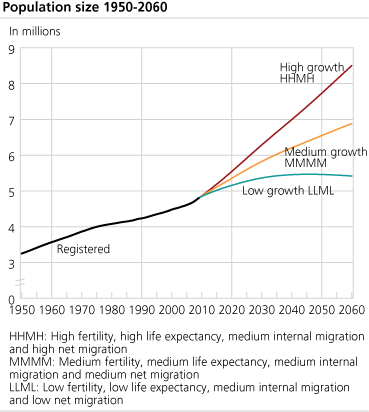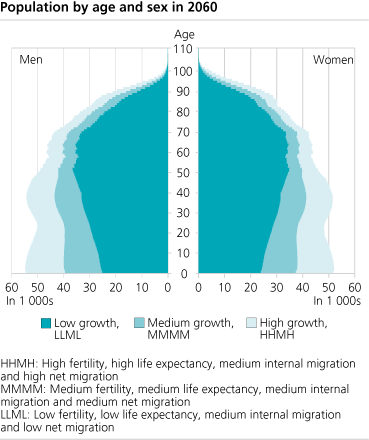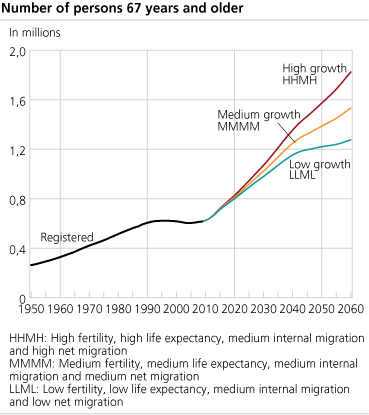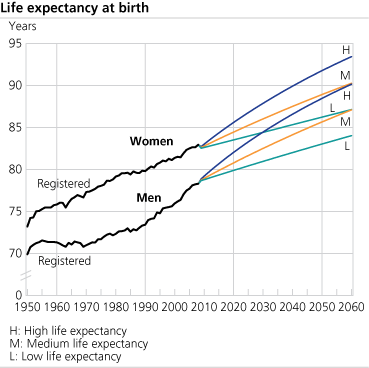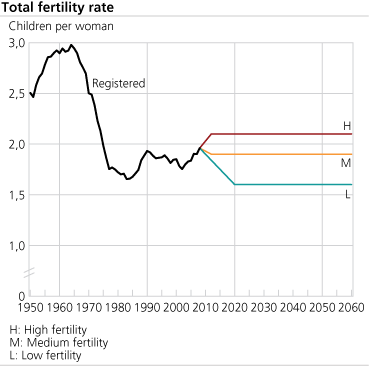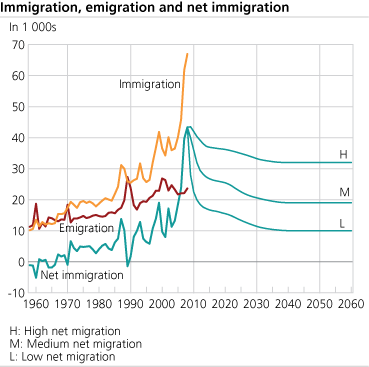Content
Published:
This is an archived release.
High population growth in the future
The population of Norway is projected to rise considerably in the period 2009 to 2060. The most important reason for this is continued high immigration. The immigration surplus is expected to decline in the next few years. Slightly higher fertility and life expectancy is expected than in the previous projections, which were published in May 2008.
The projections show that the population size is going to increase during the next 51 years, from 4.8 million in 2009 to about 6.9 million in 2060. The degree of uncertainty is high, especially in connection with future immigration flows.
Alternative assumptions
The projections have been made on the basis of alternative assumptions about the projection components: fertility , life expectancy , internal migration (mobility) and net immigration . The assumptions have been named L (low), M (medium), H (high), K (constant, for life expectancy) and 0 (for internal migration and net immigration).
The main projection variant is called MMMM, meaning medium values for fertility, life expectancy, internal migration and net immigration. For the two variants yielding the highest and lowest growth, the values for all components have been chosen to either give low growth, as in LLML, or high growth, as in HHMH. It is, however, quite unlikely that the actual development will follow these rather extreme alternatives simultaneously for an extended period.
For internal migration, we are using only one set of migration rates since variations in net immigration have a stronger effect on local population growth than likely variations in the internal migration rates.
The population is going to be much older in the long run (see the graph and the population pyramid). The number of people aged 67 and over fell from a peak of 620 000 in 1995 to slightly more than 600 000 in 2004 because the new pensioners were born in the 1930s, when the number of births was low. The number of people aged 67 and over will increase fast, from 617 000 in 2009 to around 1.6 million in 2060 - or more than twice the current level.
We have assumed slightly higher fertility than in the previous projection, which was published in May 2008, due to an increasing trend, see the table.
Life expectancy at birth is assumed to increase from 78.3 years for men and 83.0 years for women in 2008, to between 84.0 and 90.2 years for men and between 87.1 and 93.4 years for women in 2060. This is based on the Lee-Carter model applied to observations for 1900-2008.
The rapid immigration growth in recent years is related to low unemployment and economic growth in Norway, and has been facilitated by the admittance of ten East European countries to the European Union in 2004 and 2007. Citizens of these countries can work and live here almost without restriction due to Norway’s membership in the EEA (European Economic Cooperation Area).
The recent financial crisis has led to increasing unemployment in Norway and lower demand for labour, especially in the construction sector. The net immigration has already peaked and is expected to fall rapidly in the coming years.
| Registered | Alternatives | ||||||||||||||||||||||||||||||||||||||
|---|---|---|---|---|---|---|---|---|---|---|---|---|---|---|---|---|---|---|---|---|---|---|---|---|---|---|---|---|---|---|---|---|---|---|---|---|---|---|---|
| L | M | H | K | 0 | |||||||||||||||||||||||||||||||||||
| Fertility. Total fertility rate (children per woman) | |||||||||||||||||||||||||||||||||||||||
| 2008 | 1.96 | ||||||||||||||||||||||||||||||||||||||
| 2020-2060 | 1.6 | 1.9 | 2.1 | ||||||||||||||||||||||||||||||||||||
| Life expectancy at birth (years): Men | |||||||||||||||||||||||||||||||||||||||
| 2008 | 78.31 | ||||||||||||||||||||||||||||||||||||||
| 2060 | 84.0 | 87.1 | 90.2 | 78.3 | |||||||||||||||||||||||||||||||||||
| Life expectancy at birth (years): Women | |||||||||||||||||||||||||||||||||||||||
| 2007 | 82.95 | ||||||||||||||||||||||||||||||||||||||
| 2060 | 87.1 | 90.3 | 93.4 | 83.0 | |||||||||||||||||||||||||||||||||||
| Net immigration per year (number) | |||||||||||||||||||||||||||||||||||||||
| 2008 | 43 300 | ||||||||||||||||||||||||||||||||||||||
| 2009 | 28 000 | 40 000 | 43 500 | ||||||||||||||||||||||||||||||||||||
| 2010 | 22 500 | 36 000 | 42 000 | 0 | |||||||||||||||||||||||||||||||||||
| 2040-2060 | 10 000 | 19 000 | 32 000 | 0 | |||||||||||||||||||||||||||||||||||
| Internal migration | |||||||||||||||||||||||||||||||||||||||
| 2009-2060: Migration pattern as in 2003-2008 | 0 | ||||||||||||||||||||||||||||||||||||||
More detailed figures are available at http://statbank.ssb.no/statistikkbanken/?PLanguage=1 . The next set of projections is expected to be published in June 2010.
Tables:
- Table 1 Population 1 January. Registered 2009. Projected 2010-2060 in fourteen variants. 1 000
- Table 2 The number of births and deaths. Absolute and relatve population growth. Registered 2008. Projected 2009-2060 by three variants
- Table 3 Population by age per 1 January. Registered 2009. Projected 2010-2060
- Table 4 Annual growth of total population 2009-2015, by six variants. Centrality and county. Per cent
- Table 5 Population per 1 January, by county and municipality. Registered 2009. Projected 2010-2030, by variant LLML
- Table 6 Population per 1 January, by county and municipality. Registered 2009. Projected 2010-2030, by variant MMMM
- Table 7 Population per 1 January, by county and municipality. Registered 2009. Projected 2010-2030, by variant HHMH
- Table 8 Population per 1 January, by county and municipality. Registered 2009. Projected 2010-2030, by variant MMML
- Table 9 Population per 1 January, by county and municipality. Registered 2009. Projected 2010-2030, by variant MMMH
Contact
-
Statistics Norway's Information Centre
E-mail: informasjon@ssb.no
tel.: (+47) 21 09 46 42
-
Inquiries about national projections
E-mail: nasjfram@ssb.no
-
Inquiries about regional projections
E-mail: regfram@ssb.no
-
Michael Thomas
E-mail: michael.thomas@ssb.no
tel.: (+47) 40 90 26 28
-
Ane Margrete Tømmerås
E-mail: ane.tommeras@ssb.no
tel.: (+47) 91 99 29 62

